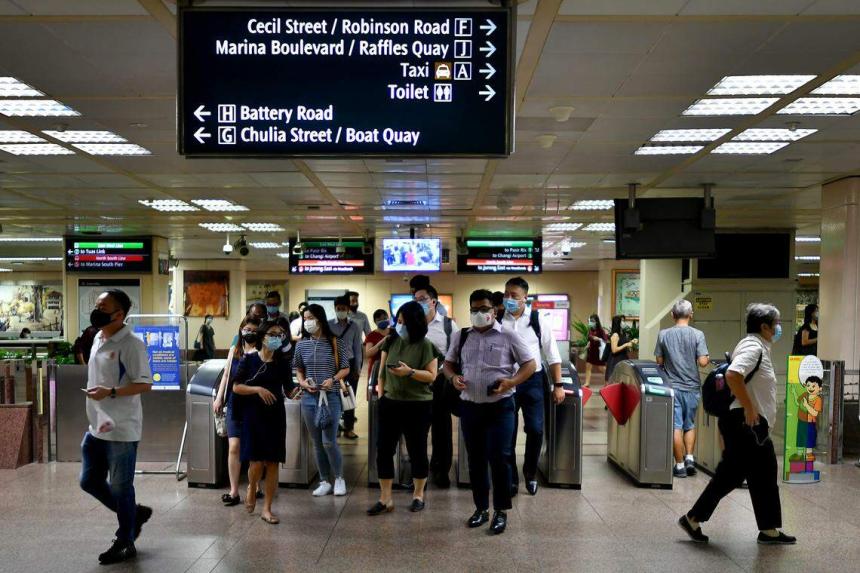SINGAPORE - A new formula will be used to determine public transport fares, from 2023 to 2027.
The Public Transport Council on Tuesday announced changes to the fare adjustment formula after its latest review, which is conducted every five years. The formula is used in the annual fare revision exercise to determine the maximum amount that bus and train fares can change after accounting for various factors that influence the operation of public transport services.
What’s new: Productivity contribution and capacity adjustment factor
By design, the formula takes into account the cost of running public transport operations. This would include the core inflation rate, wage and energy costs.
In the updated formula, there is one new fixed component: the capacity adjustment factor which works out to 1.1 per cent per year for five years.
It replaces the network capacity factor (NCF), which is a variable component that reflected operating costs due to network capacity changes relative to ridership.
The change aims to reduce the likelihood of big swings in public transport fares for commuters.
Meanwhile, the productivity component of the formula remains fixed at 0.1 per cent for the next five years. However, it has been changed to a productivity contribution, instead of the existing productivity extraction where half of the transport operators’ productivity gains was shared with commuters.
Why PTC changed the productivity extraction component
The new productivity contribution is fixed as a 0.1 per cent reduction to the overall fare adjustment.
The PTC said this is to “maintain the expectation for public transport operators to strive for continuous productivity improvements”. In other words, the operators have to find the needed efficiencies to offset against the 0.1 per cent revenue reduction.
This component replaces the productivity extraction factor, which was added to the fare formula in 2005 and set at half of the productivity gains that the operators have managed over the previous five years.
This was set at 0.1 per cent for the 2018 to 2022 period, as the transport operators achieved average productivity gains - measured as the growth in value added per employee - of 0.2 per cent per year from 2012 to 2016.
In the 2013 fare formula that was applied to fare reviews from 2013 to 2017, the productivity extraction was 0.5 per cent.
PTC noted that the Covid-19 pandemic had a major impact on the operators’ productivity. As their productivity losses would not be passed on to commuters, the productivity extraction would have been set at zero, said PTC.
However, the council proposed a productivity contribution of 0.1 per cent to signal to the operators that they should improve productivity and efficiency.
Replacing the network capacity factor (NCF)
The capacity adjustment factor adds 1.1 per cent for the next five years to the fare review formula. This is an average figure to capture the growth in public transport network capacity between 2020 and 2026 spread over the period of 2023 to 2027, when the latest formula would apply.
It replaces the NCF, which was introduced when the fare review formula was reviewed in 2018.
NCF is a function of the amount of capacity in the public transport network and the user demand. Basically, if capacity increased faster than ridership, a higher fare hike would be allowed.
This became an issue when the onset of the Covid-19 pandemic sent ridership into a nosedive. In 2018, the NCF accounted for 3.0 per cent of the fare increase.
In 2019, the figure was 1.6 per cent, and 3.9 per cent in 2020.
It was partially excluded from the 2021 fare review exercise as the dip in ridership meant that NCF worked out to be 50 per cent. The PTC said that this would have meant raising fares by approximately 60 cents before taking the other components into account.
It was also for this reason that NCF was fully excluded in the fare adjustment calculation for the 2022 exercise.
There is no certainty that ridership will recover to pre-pandemic levels over the next few years, the PTC noted.
At the same time, it was important to reflect the expansion of the public transport network - a major factor in rising costs - in the fare formula, PTC said. It decided to fix the capacity adjustment factor at 1.1 per cent each year and exclude ridership to avoid the year-to-year changes that affected the NCF.
The council added that the factor largely reflects the improved connectivity and shorter travel times arising from the opening of the Thomson-East Coast Line.
What does it mean for passengers?
Given that the three major components in the calculation: the core inflation rate, wage and energy costs have not shown signs of coming down in the coming months, it is likely that fares will go up.
On its part, the PTC said the new formula will reduce big swings in bus and train fares from year to year.
The PTC has also retained a mechanism to defer fare adjustments, which allows it to shield commuters from fare increases during periods such as the Covid-19 pandemic, or from large fare hikes due to sudden spikes in costs.
In the 2022 fare review exercise which excluded the NCF, the maximum fare increase was calculated to be 13.5 per cent but only 2.9 per cent - an increase of four to five cents more for adults who pay for their bus and train rides by card - was granted.
The remaining 10.6 per cent increase was carried over to the 2023 fare review exercise.
Asked at a press conference on Tuesday about the fact that fares look set to rise, given factors like the 10.6 per cent rollover from last year’s exercise, PTC chairman Janet Ang replied: “There’s no way to be negative.”


